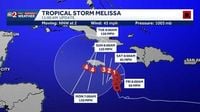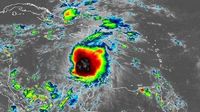Tropical Storm Melissa, the thirteenth named storm of the 2025 Atlantic hurricane season, has become the latest focal point for meteorologists and residents across the Caribbean as it churns slowly through the region. As of early Thursday, October 23, 2025, the National Hurricane Center (NHC) reported Melissa’s core was located about 300 miles southwest of Port-au-Prince, Haiti, and roughly 240 miles south-southeast of Kingston, Jamaica. The storm was crawling along at a mere 3 miles per hour—slower than the average person walks—packing maximum sustained winds of 50 mph and extending tropical storm-force winds up to 115 miles from its center.
Melissa’s sluggish movement is a double-edged sword. According to the NHC, while the storm is not expected to change much in strength in the next day or so, significant intensification is likely by late Friday and over the weekend. CBS News meteorologist Nikki Nolan noted, “Melissa is forecast to become a major hurricane by early next week.” That could mean a Category 3 or even Category 4 storm—an escalation that would bring even greater risks to the islands in its path.
Forecasting Melissa’s exact trajectory and intensity has proven tricky for meteorologists. The storm is expected to drift closer to Jamaica and the southwestern portion of Haiti over the next couple of days, with a possible westward turn over the weekend. "A slow northwest or north motion is forecast during the next couple of days, followed by a westward turn over the weekend. On the forecast track, Melissa is expected to be nearer to Jamaica and the southwestern portion of Haiti during the next couple of days," the NHC said, as reported by Fox35 Orlando. However, the forecast models remain divided on whether Melissa will eventually veer off to the northeast or stall out in the north-central Caribbean.
As of now, a hurricane watch is in effect for the southwestern peninsula of Haiti, stretching from the Dominican Republic border to Port-au-Prince. Jamaica is under a tropical storm warning, and residents have been urged to stay alert for rapidly changing conditions. The slow pace of the storm is particularly concerning: as The Washington Post pointed out, hurricanes typically require pushes from other weather systems—like cold fronts or jet stream dips—to move swiftly. In Melissa’s case, those influences are weak or absent, allowing the storm to meander for days and dump torrential rainfall on the same areas.
Rainfall projections are sobering. The NHC warned that Melissa is likely to bring between 5 and 10 inches of rain to the southern Dominican Republic, southern Haiti, and eastern Jamaica through Sunday, October 26, with locally higher amounts possible. The risk doesn’t end there; additional heavy rainfall is possible beyond Sunday, raising the specter of significant, life-threatening flash flooding and numerous landslides. “Significant, life-threatening flash flooding and numerous landslides are possible,” forecasters cautioned.
For many in the region, the threat of flooding is compounded by local geography. The tall mountains of Hispaniola and Jamaica tend to wring out moisture from the atmosphere, intensifying rainfall. The storm’s extended proximity to land means these areas could face days of relentless downpours, a scenario that has proven disastrous in past storms. Hurricane Harvey in 2017, for example, stalled over southeastern Texas and produced a record 60.58 inches of rain, as highlighted by The Washington Post.
While there is no direct threat to Florida or the United States at this time, forecasters are keeping a close eye on Melissa’s path. Florida could see increased surf and rip currents along its beaches, but the current chance of any direct or indirect impacts beyond that is low, around 15%, according to AccuWeather Lead Hurricane Expert Alex DaSilva. “If Florida were to see any impacts, it would likely be around the middle of next week—Wednesday through Friday (Oct. 29-31). There’s nothing imminent right now, but it’s something to keep an eye on over the next few days as we monitor trends and model data,” DaSilva said in an email on October 21.
Adding to the uncertainty, the National Hurricane Center is also monitoring two other tropical waves in the Atlantic basin. With the hurricane season running through November 30, and the peak typically occurring in September, the tropics remain active and unpredictable. The NHC has emphasized that the forecast track only shows the most likely path of the storm’s center and not the full width of its impacts, which can extend far beyond the so-called “cone of uncertainty.”
Why has Melissa been moving so slowly? Meteorologists point to a combination of unusually hot Caribbean waters and weak upper-level winds. “The potential intensity is quite elevated in the Caribbean, compared to the 1979-2023 average for this time of year,” said Kerry Emanuel, a tropical cyclone expert at the Massachusetts Institute of Technology, in comments reported by The Washington Post. These conditions not only slow the storm’s forward speed but also provide ample energy for strengthening. In fact, slow-moving storms like Melissa are becoming more common in the Atlantic Basin, especially near land masses. Studies in recent years have documented a slowdown in hurricane forward speed at landfall, which means storms linger longer and produce more flooding rainfall.
Some research has tentatively linked this trend to global warming, but the scientific community is not yet in full agreement. Meteorologist Kieran Bhatia of Guy Carpenter pointed out that while some studies show a slowdown in tropical cyclone speeds over the continental U.S. and near-coastal regions, “these observed changes have not yet been confidently linked” to human-caused climate change. The most recent UN Intergovernmental Panel on Climate Change report found a trend that cannot be explained solely by natural variability, but with only “medium” confidence. Nonetheless, there’s broad consensus that tropical storms and hurricanes are producing more rainfall now than in the past, thanks to warmer ocean and air temperatures that allow the atmosphere to hold more moisture.
As Melissa threatens to become a major Category 4 hurricane, the region braces for days of uncertainty and potential devastation. The 2025 Atlantic hurricane season, which began June 1 and ends November 30, has already seen its share of surprises, and Melissa is shaping up to be one of its most memorable storms. For now, residents of Jamaica, Hispaniola, and nearby islands are urged to heed official warnings, prepare for possible flooding, and stay tuned for updates as the storm’s path and strength continue to evolve.
With the tropics in flux and the science of hurricane prediction still evolving, Melissa is a stark reminder of the power and unpredictability of nature—and the importance of vigilance as the season continues.

